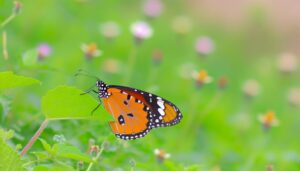Which Caterpillar Turns Into the Iconic Monarch Butterfly?
The caterpillar that metamorphoses into a monarch butterfly (*Danaus plexippus*) is distinctly identifiable by its black, white, and yellow striped pattern. Exclusively feeding on milkweed, this larva accumulates essential nutrients and toxins necessary for its defense and rapid growth.
Throughout its larval stage, the monarch caterpillar undergoes five molts, culminating in a length of approximately 1.25 to 2 inches before entering the pupal stage. Following an intricate transformation within the chrysalis, a fully-developed monarch butterfly emerges with its iconic orange and black wings.
For further understanding of this complex lifecycle and migration patterns, continue exploring.

Key Takeaways
- The caterpillar that turns into a monarch butterfly is exclusively a monarch caterpillar.
- Monarch caterpillars have distinct black, white, and yellow striping patterns.
- They feed exclusively on milkweed plants during their larval stage.
- Monarch caterpillars undergo five instars, growing up to 2 inches in length.
Monarch Butterfly Overview
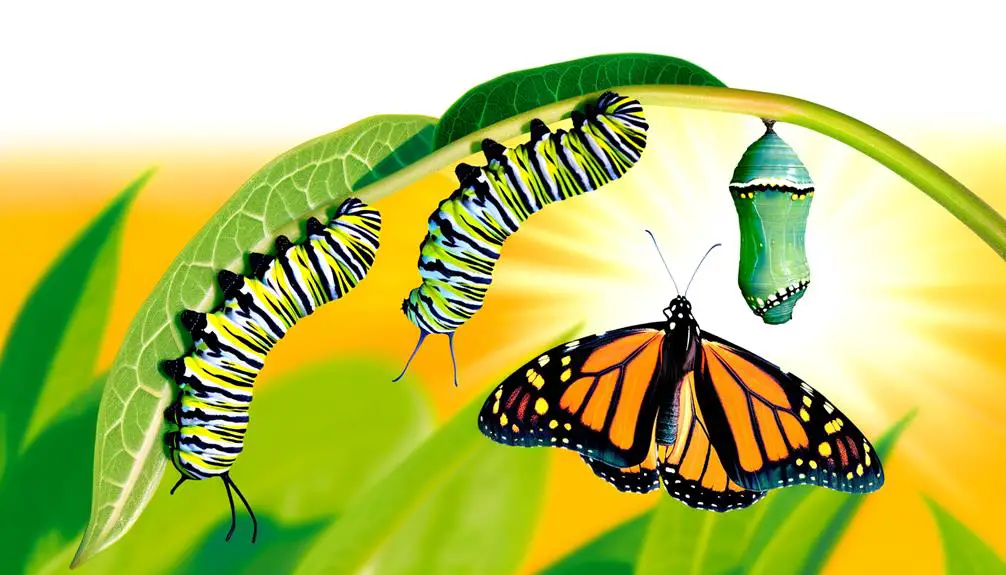
The Monarch butterfly (Danaus plexippus) is a migratory species renowned for its striking orange and black wing pattern, intricate life cycle, and extraordinary long-distance migration.
Native to North America, Monarchs undertake an annual journey spanning thousands of miles from breeding grounds in Canada and the United States to overwintering sites in central Mexico. This migration is a multi-generational endeavor, with successive generations completing different legs of the trip.
Monarchs exhibit sexual dimorphism, where males possess distinct black spots on their hind wings. They primarily feed on nectar from various flowers, while their larvae exclusively consume milkweed, a plant containing toxins that render the butterflies distasteful to predators.
Their survival is intricately linked to the availability of milkweed and suitable habitats.
Egg Stage
During the egg stage, monarch butterflies lay tiny, white eggs primarily on the underside of milkweed leaves.
This strategic placement not only provides a secure attachment but also guarantees an immediate food source for the emerging larvae.
The eggs, approximately 1.2 millimeters in diameter, exhibit a conical shape with a series of vertical ridges that facilitate adhesion to the leaf surface.
Tiny White Eggs
Upon close inspection of milkweed leaves, one can observe the minute, spherical white eggs that herald the beginning of the monarch butterfly's life cycle. These eggs, approximately 1.2 mm in diameter, are laid individually by the female monarch. The egg stage lasts about 3 to 5 days, during which embryonic development occurs. Each egg contains a developing larva, which will eventually emerge as a caterpillar, ready to begin its journey of transformation.
| Egg Characteristics | Details | Significance |
|---|---|---|
| Size | ~1.2 mm diameter | Ease of concealment from predators |
| Color | White | Camouflage against milkweed |
| Duration | 3-5 days | Rapid development |
| Placement | Underside of leaves | Protection and moisture |
This brief yet essential stage sets the foundation for the monarch's metamorphosis.
Leaf Attachment Process
When laying her eggs, the female monarch butterfly employs a specialized adhesive to secure each egg to the underside of milkweed leaves, ensuring stability and protection during the early stages of development.
This adhesive, secreted during oviposition, possesses remarkable tenacity, binding the egg firmly to the leaf surface. The positioning under the leaf minimizes exposure to predation and environmental hazards, such as wind and rain.
The milkweed leaf itself is biologically significant, providing the essential nutrients necessary for the emerging larva. This strategic attachment not only anchors the egg but also optimizes the caterpillar's initial access to food sources upon hatching.
The process exemplifies an evolutionary adaptation that maximizes survival rates during the monarch's vital egg stage.
Larva Stage
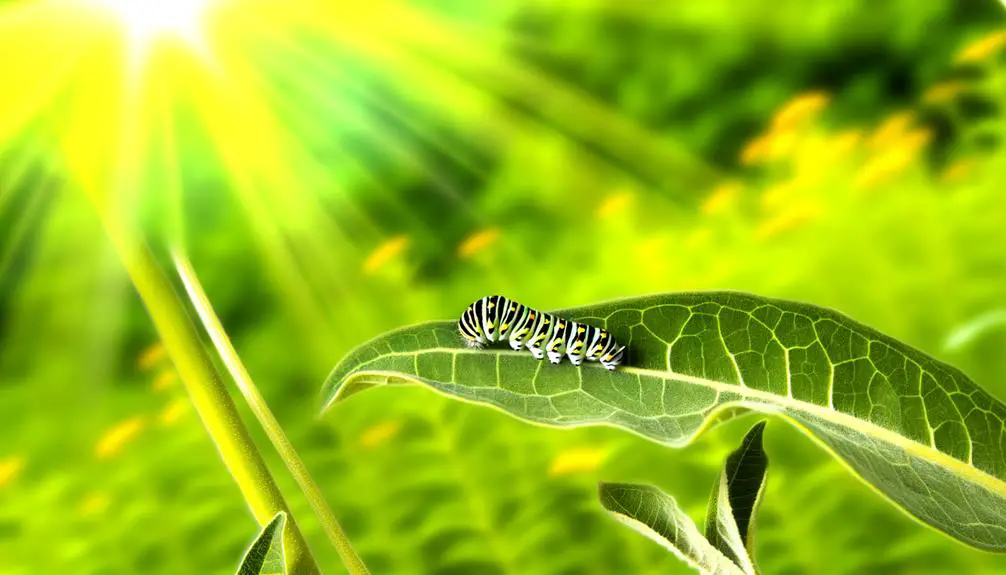
The larva stage, characterized by rapid growth and development, is a crucial period in the life cycle of the monarch butterfly, during which the caterpillar undergoes multiple molts and greatly increases in size.
During this stage, the monarch caterpillar, or larva, primarily focuses on feeding and accumulating energy reserves. It consumes large quantities of milkweed, the sole food source, which provides essential nutrients and toxins that offer protection against predators.
The caterpillar undergoes five instars, molting between each to accommodate its rapid growth. This process is imperative for the caterpillar to reach its full potential size before progressing to the next life stage.
Throughout these transformations, enzymatic activity and hormonal changes orchestrate the developmental processes necessary for metamorphosis.
Monarch Caterpillar Identification
Identifying a monarch caterpillar involves noting its distinct black, white, and yellow striping pattern that runs longitudinally along its body. This striking coloration serves as a key identification feature, distinguishing it from other caterpillar species.
The monarch caterpillar typically measures between 1.25 to 2 inches in length during its final instar stage. Its head features a pair of slender, black tentacles, while similar, shorter tentacles are located near the rear.
These tentacles, though often mistaken for antennae, serve a different sensory function. The caterpillar's body is smooth and lacks the spines or bristles seen in other species.
Observing these characteristics enables precise identification, ensuring accurate recognition of this important stage in the monarch butterfly's life cycle.
Feeding Habits
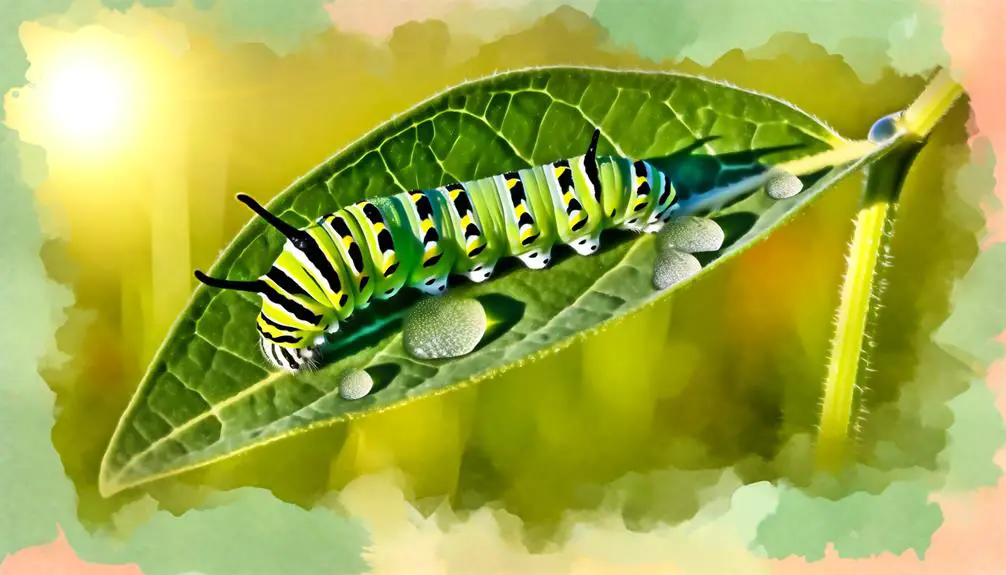
The feeding habits of monarch caterpillars are intrinsically linked to their dependency on the milkweed plant, which serves as their exclusive food source during the larval stage.
This dependency is critical, as the milkweed provides the necessary nutrients and toxic compounds that caterpillars sequester for defense against predators.
Understanding the specific nutritional requirements at this stage is essential for comprehending their survival strategies and overall lifecycle.
Milkweed Plant Dependency
Essential to the survival of both caterpillars and adult monarch butterflies, the milkweed plant serves as the primary food source and habitat during the larval stage. This symbiotic relationship is critical, as milkweed provides the necessary chemical compounds known as cardenolides, which are toxic to many predators.
These compounds are sequestered by the larvae and retained through metamorphosis, offering protection to the adult butterflies. Milkweed plants also offer structural support, providing a secure environment for egg-laying and subsequent caterpillar development.
The dependency on milkweed underscores the importance of preserving these plants in natural and cultivated environments, ensuring the continued existence of monarch populations and maintaining ecological balance.
Conservation efforts are therefore essential for sustaining this intricate life cycle.
Larval Stage Diet
During the larval stage, monarch caterpillars primarily consume the leaves of milkweed plants, which provide essential nutrients and chemical defenses important for their development. This exclusive diet is rich in cardenolides, a type of cardiac glycoside, which not only supports the caterpillar's growth but also confers a chemical defense against predators.
Monarch larvae exhibit selective feeding behaviors, favoring younger, more tender milkweed leaves. This preference guarantees ideal intake of moisture and nutrients. Additionally, the caterpillars employ a unique feeding strategy, creating trenches in the leaves to reduce latex flow—a defensive mechanism of the milkweed plant.
Such specialized feeding habits are vital for the monarch caterpillar's successful progression through its larval stage, ultimately influencing its survival and metamorphosis into a butterfly.
Nutritional Requirements
Monarch caterpillars' nutritional requirements are intricately tied to their specialized feeding habits, which guarantee they receive specific nutrients and compounds necessary for their development. These larvae exclusively feed on milkweed plants, which provide them with essential nutrients and defensive chemicals.
This diet guarantees the following:
- Cardenolides (Cardiac Glycosides): These toxic compounds protect caterpillars from predators by making them unpalatable.
- Nutrients for Growth: Milkweed supplies essential amino acids, lipids, and carbohydrates critical for rapid growth and metamorphosis.
- Moisture: Milkweed leaves have a high water content, essential for maintaining hydration and physiological processes.
The caterpillar's strict diet not only supports its growth but also confers advantages that extend into its adult butterfly stage, securing survival and reproductive success.
Growth and Molting
As the caterpillar progresses through its larval stages, it undergoes a series of molts, shedding its exoskeleton to accommodate its rapid growth.
Each molt, or ecdysis, allows the larva to expand, a process regulated by hormones such as ecdysone.
This metamorphic journey comprises five instars, during which the caterpillar consumes copious amounts of milkweed, its primary food source.
During each instar, the caterpillar's body enlarges markedly, necessitating the shedding of its restrictive outer layer.
This shedding process is critical for development, as it enables the larva to continue its physiological and cellular growth.
The intervals between molts are characterized by intense feeding and nutrient absorption, essential for the caterpillar's subsequent transformation into the pupal stage.
Pupa Stage
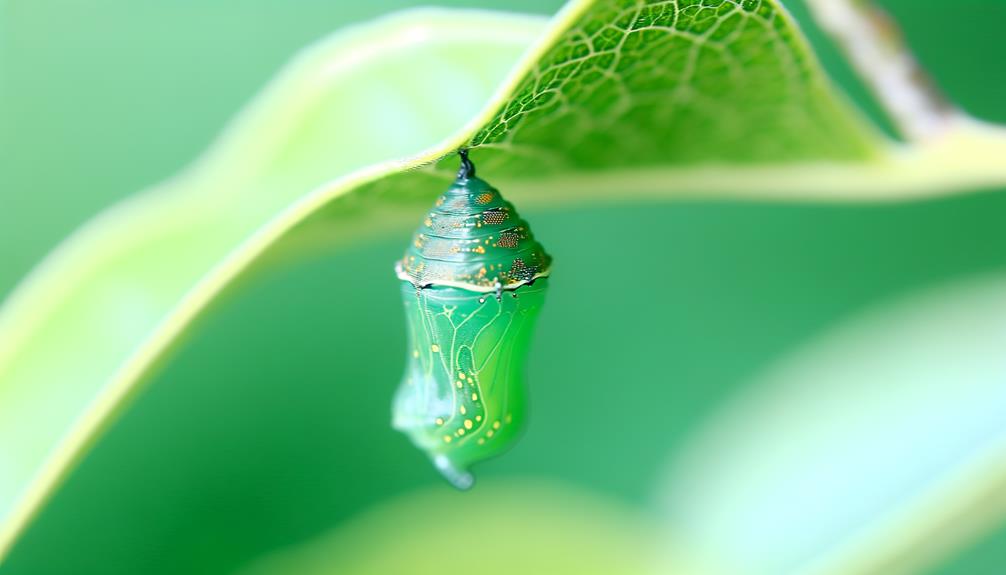
During the pupa stage, the caterpillar undergoes a remarkable transformation within the protective casing of the chrysalis.
This metamorphic process, known as chrysalis transformation, involves extensive cellular reorganization and differentiation.
The duration of pupa development varies, typically spanning between 10 to 14 days, contingent upon environmental factors such as temperature and humidity.
Chrysalis Transformation Process
The chrysalis transformation process, also known as the pupa stage, represents a critical phase in the life cycle of the monarch butterfly, characterized by extensive cellular reorganization and development. During this stage, the caterpillar undergoes a metamorphic transformation within the protective chrysalis, converting into an adult butterfly.
Here are key aspects of this intricate process:
- Histolysis: Enzymes break down the caterpillar's tissues, reducing them to a nutrient-rich soup.
- Histogenesis: Imaginal discs, clusters of cells present since the larval stage, proliferate and differentiate into adult structures such as wings, legs, and antennae.
- Hormonal Regulation: Hormones like ecdysone and juvenile hormone precisely coordinate the timing and sequence of developmental events.
This extraordinary transformation guarantees the emergence of a fully formed monarch butterfly.
Pupa Development Duration
Typically lasting between 8 to 15 days, the pupa stage's duration is influenced by various factors, including temperature, humidity, and genetic predisposition.
During this critical phase, the developing Monarch butterfly undergoes significant metamorphosis within the chrysalis.
Temperature plays a pivotal role; warmer conditions tend to accelerate development, while cooler temperatures may prolong it.
Humidity levels also impact the process, as excessive dryness or moisture can hinder proper development.
Genetic factors contribute to individual variability in pupation duration, highlighting the inherent adaptability of Monarch butterflies.
This stage culminates in the emergence of an adult butterfly, ready to commence on its migratory journey, signifying the remarkable transformation that has taken place within the protective confines of the chrysalis.
Chrysalis Transformation
As the caterpillar enters the pupal stage, it forms a protective chrysalis where profound morphological changes occur, leading to the emergence of a monarch butterfly.
Within this chrysalis, the caterpillar undergoes metamorphosis, a complex process driven by hormonal changes and cellular reorganization.
Key transformations include:
- Histolysis: Breakdown of larval tissues to make way for the development of adult structures.
- Histogenesis: Formation and differentiation of new tissues and organs, including wings, antennae, and reproductive organs.
- Chitin Production: Synthesis of a robust exoskeleton to support the adult butterfly's structure.
These meticulously orchestrated processes guarantee the caterpillar's transformation is both seamless and effective, culminating in the creation of an exquisite monarch butterfly ready for flight.
Emerging Butterfly
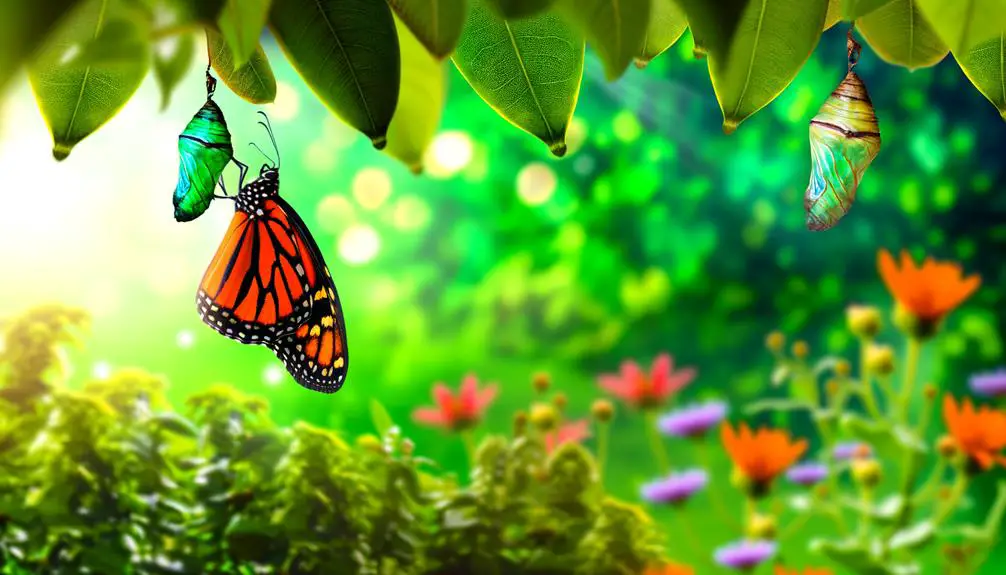
Upon completion of metamorphosis, the newly formed monarch butterfly meticulously emerges from the chrysalis, revealing its vibrant wings and finely structured body.
This precise process begins with the insect gradually splitting the chrysalis shell. The butterfly then extricates itself, initially presenting crumpled wings.
Over the next several hours, hemolymph is systematically pumped through the wing veins, causing them to expand and harden. Concurrently, the butterfly's proboscis, a specialized feeding tube, unfurls and fuses properly.
The exoskeleton solidifies, and the vibrant orange and black coloration becomes more pronounced. During this critical period, the monarch remains vulnerable but immobile, allowing its wings to dry and strengthen before it can take its first flight, marking the completion of its incredible transformation.
Monarch Migration
Monarch migration is a remarkable phenomenon characterized by the long-distance travel of millions of butterflies from North America to central Mexico, spanning thousands of miles in search of favorable overwintering habitats. This annual journey is driven by the monarch's need for specific environmental conditions to survive the winter.
Utilizing internal genetic cues and environmental signals, monarchs navigate using a combination of the sun's position and Earth's magnetic field.
To illustrate this migration:
- Distance: Monarchs travel up to 3,000 miles from Canada and the United States to central Mexico.
- Generations: The full migration cycle spans multiple generations, with only the “super generation” making the entire round trip.
- Overwintering Sites: Monarchs cluster in the Oyamel fir forests of the Trans-Mexican Volcanic Belt, where microclimates provide necessary temperature and humidity.
Conclusion
The metamorphosis of Danaus plexippus, commonly known as the monarch butterfly, encompasses distinct developmental stages: egg, larva, pupa, and adult.
During the larval stage, the monarch caterpillar exhibits specific feeding behaviors and morphological traits, primarily consuming milkweed.
The transformative journey includes the formation of a chrysalis, within which profound physiological changes occur.
Ultimately, the emergence of the adult butterfly signifies the completion of this remarkable lifecycle, culminating in the species' well-documented migratory phenomenon.





